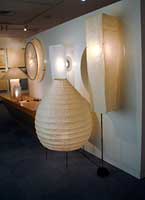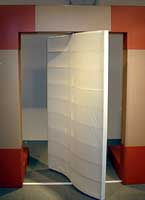|
|
|||||||
|
|
|||||||
|
|||||||
| | Web Japan >> | Trends in Japan >> | Lifestyle >> | The Pleasures of Paper | |
|
THE PLEASURES OF PAPER Washi Increasingly Used in Interior Design (September 14, 2005) Japanese paper is prized for the unique patterns of the fibers on each sheet. Today, washi is finding growing use in interior decoration schemes, reflecting a broader trend, particularly among young people, to get back in touch with Japanese culture. Traditional items such as fusuma sliding doors made from opaque paper and shoji panels, which are translucent, are selling well, as are washi curtains and lamp shades, which diffuse light and make a room look warm and cozy. Single sheets of paper are also in big demand, as more and more people line tables and shelves with washi and discover that it offers an inexpensive way to give a room a special touch. The Warmth of Washi Interiors with a washi accent are enjoying a lot of popularity. Pleated blinds and curtains made from washi are selling well because they diffuse and give off a softer light than cloth. They also cast shadows, owing to unevenness in color and thickness, which is another big selling point. Though the paper cannot be washed, it lasts a long time if cleaned with a duster. Washi lamp shades, meanwhile, help to warm up a room. The foremost figure in the modern use of washi is Horiki Eriko, who has created a variety of objects using washi to embellish architectural space. Her basic material is sheets of original washi made by modern techniques, each of which measures 2,100 cm by 2,700 cm. Using these sheets, Horiki has composed decors that blend light and paper in hotels, restaurants, universities, post offices, wedding facilities centers, and other settings. She also offers products made of her paper, including "light walls," "light pillars," tapestries, and lamps. Horiki's works are highly accepted both in Japan and worldwide. A Good Match for Any Decor Though it is a traditional Japanese craft, washi provides a stylish accent to Western-style interiors. Tasteful place mats can be created by gently tearing the paper along the edges. Vases can be made from small bottles by covering them with washi. And shoji can be given a stained glass effect by replacing the conventional white paper with different colors and designs in each frame. Handmade paper costs more than machine made, but at about ¥3,000 ($27 at ¥110 to the dollar) a square meter, it is still a good deal for people who want a change in decor. The versatility and warmth of washi mean that it is likely to retain its status as a favorite material for interior design. Related videoJapan Video Topics : WASHI- The Finest Japanese Paper Copyright (c) 2005 Web Japan. Edited by Japan Echo Inc. based on domestic Japanese news sources. Articles presented here are offered for reference purposes and do not necessarily represent the policy or views of the Japanese Government. |
TEACHING OLD HOUSES NEW TRICKS (August 3, 2005) HOME IS WHERE THE ART IS (January 21, 2004) THE SOUND OF SILENCE (October 17, 2003) |
|
|




